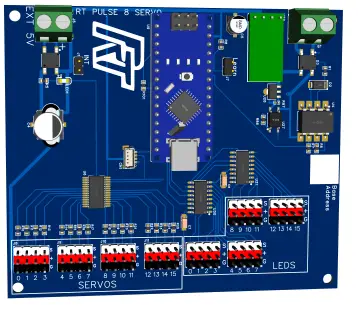Story
Schumann resonances are global electromagnetic resonances, generated by lightning discharges in the space formed by the Earth's surface and the ionosphere. The primary frequency of Schumann resonance is around 7.83 Hz and has several harmonic frequencies, including 14.07 Hz, 20.25 Hz, 26.41 Hz, and 32.45 Hz.

Multiple studies suggest that the Schumann frequency of 7.83 Hz positively affects human health and well-being. It has been linked to improved cognitive functions, reduced stress , enhanced immune function, sleep function, and much more. For example the Alpha brain wave activities [between 7 and 14 Hz] are a state wherein a person is relaxed. This frequency is also often used in PEMF therapy devices for general improvement of the body's condition, reducing the effects of stress and improving sleep.
This time I will present you an exclusively simple way to make such a PEMF device using a cheap Schumann frequency generator module, and an amplifier of generated signal.
You can watch the video presentation of the device at the following link: https://youtu.be/As8qPQ6ZRDU
Otherwise, this module costs only a few dollars, and according to the seller's claim, it should radiate an electromagnetic field with this frequency. A so-called pancake coil is made on the PCB, which is supposed to be the source of the radiation.

Now let's test the function of this module to examine the shape and strength of the signal, and the frequency at which it oscillates. For this purpose, I will use an oscilloscope, as well as an electromagnetic radiation detector, which is actually a coil from a small electromagnetic relay that is connected to the microphone input of the PC.

Under the action of the variable magnetic field, a current is induced in the coil, which is then amplified and then manifests as clicks on the PC speaker.
First let's check the oscillation frequency: Two points are the output of the oscillator. As we see the frequency is 6.5Hz. On the board there is a small trimmer potentiometer with which we can precisely set the desired frequency. Unfortunately, on my particular module, the maximum frequency that could be set was about 7.5 Hz. To correct that, in place of small 360Kohm resistor, I connected a 2M resistor in parallel. After this modification I can set exactly the requested frequency of 7.83Hz.

This is the only sample I own, so I hope your sample can be tuned to the correct frequency without any modifications. Here is what my modified module looks like

Now let's check if this little PCB coil emits EMF rays at all. The module is made on the basis of a timer IC - 555 and the output of the circuit is directly connected to the PCB coil. This means that a current of several tens of milliamps flows through the coil, which is not enough for practical use. The distance at which the field is detected is extremely small and amounts to about 1cm. This is a very weak field and can possibly be used placed directly on some part of the body. My idea is to make a device that would be connected somewhere in the living room or bedroom and would radiate throughout the room and would have the function of a relaxer or sleep enhancer

For that purpose, I made a device that will amplify this rectangular pulsating signal with a powerful mosfet transistor, and I will bring it to a suitable coil made of insulated copper wire which will be a source of strong electromagnetic radiation.
Let's take a look at what's inside the box:

The mosfet is mounted on an aluminum heatsink and powered by an external 12V /2A source. I also used a 7805 voltage regulator to power the module. Making the coil is not critical, but some general conditions must be observed. In this particular case, the coil consists of lacquered wire with a diameter of 0.2 mm and a total length of 12 m, while the ohmic resistance of the coil is 8 Ohms. As a general recommendation, the ohmic resistance of the coil should not be less than 2 ohms or more than 10 ohms, and the copper wire should have a cross-sectional area between 0.2 and 0.5 mm2.
Now let's see how this device works in reality. When the voltage is switched on, one LED lights up constantly, and the other flashes with a frequency of 7.86 Hz. This is a basic sign that the device is working. So that you can see the difference between the original module and the device after the modification I have installed this BOOST switch.

When it is in position 0, only the original module works, and in position 1, is turns on the mosfet amplifier with a new coil . Next, let's check the strength of the electromagnetic field with the previously described detector. As you can see now the detector reacts at a distance greater than 50cm. Taking into account the fact that the field strength decreases proportionally to the square of the distance from the source, this means that now the EMF radiation is tens of times stronger than at the module itself. Now the strength of the magnetic field has a value of about 10 Gauss. For a better visual and so-called Placebo effect, I mounted the module on the front of the box.
And finally a short conclusion. In this video I described a very simple way to turn this module into a really functional and cheap PEMF device that is usually sold at a very high price.
I am not a medical expert and I cannot discuss the effect of the device. If you are considering usе it for health-related purposes, it is crucial to consult a qualified healthcare professional to ensure safety and efficacy. This video only explains the technical aspect of this device (how to build it).


















































